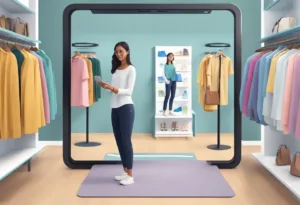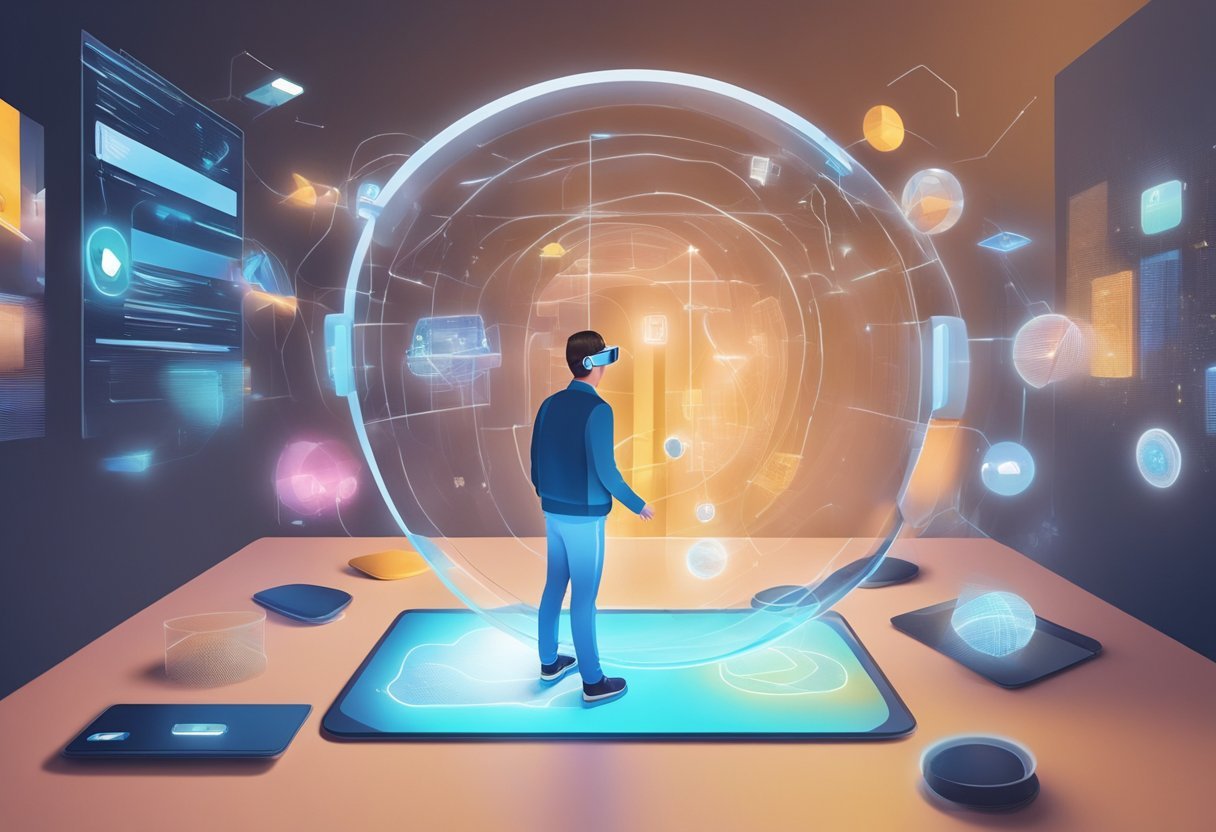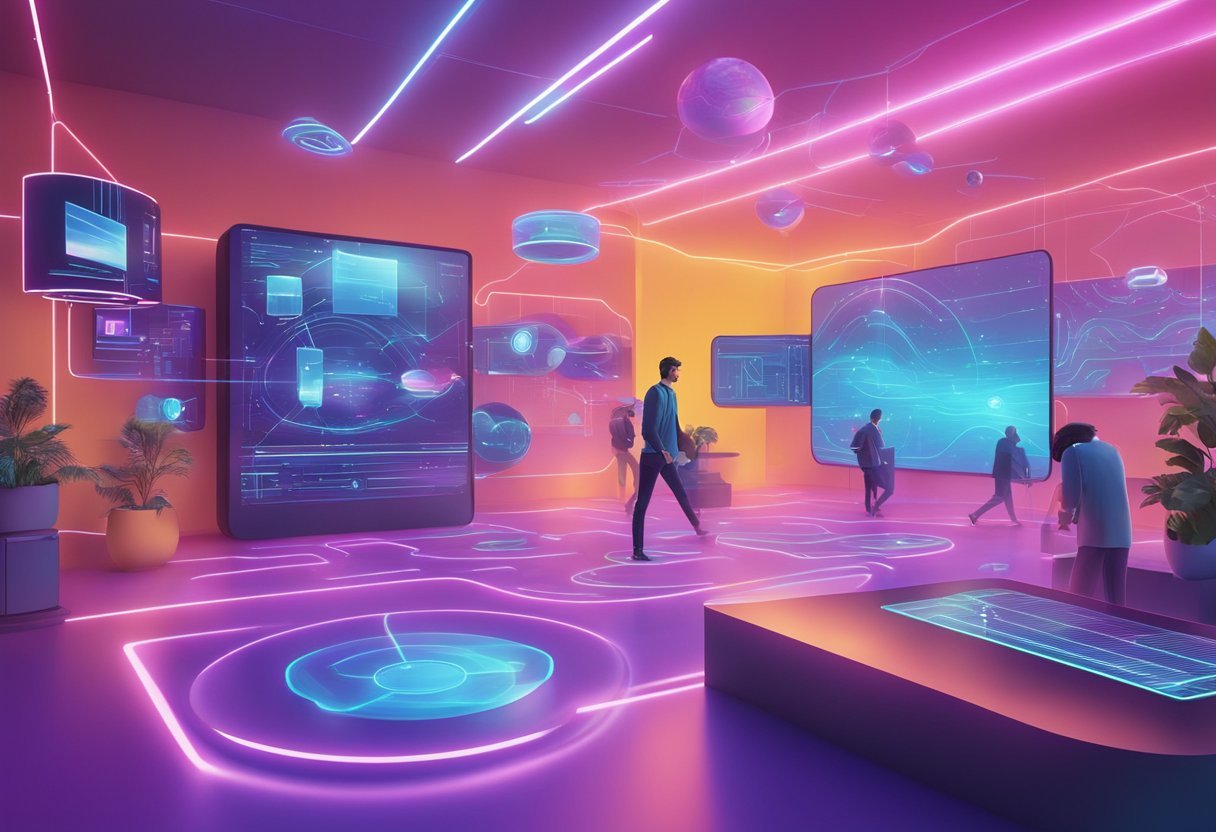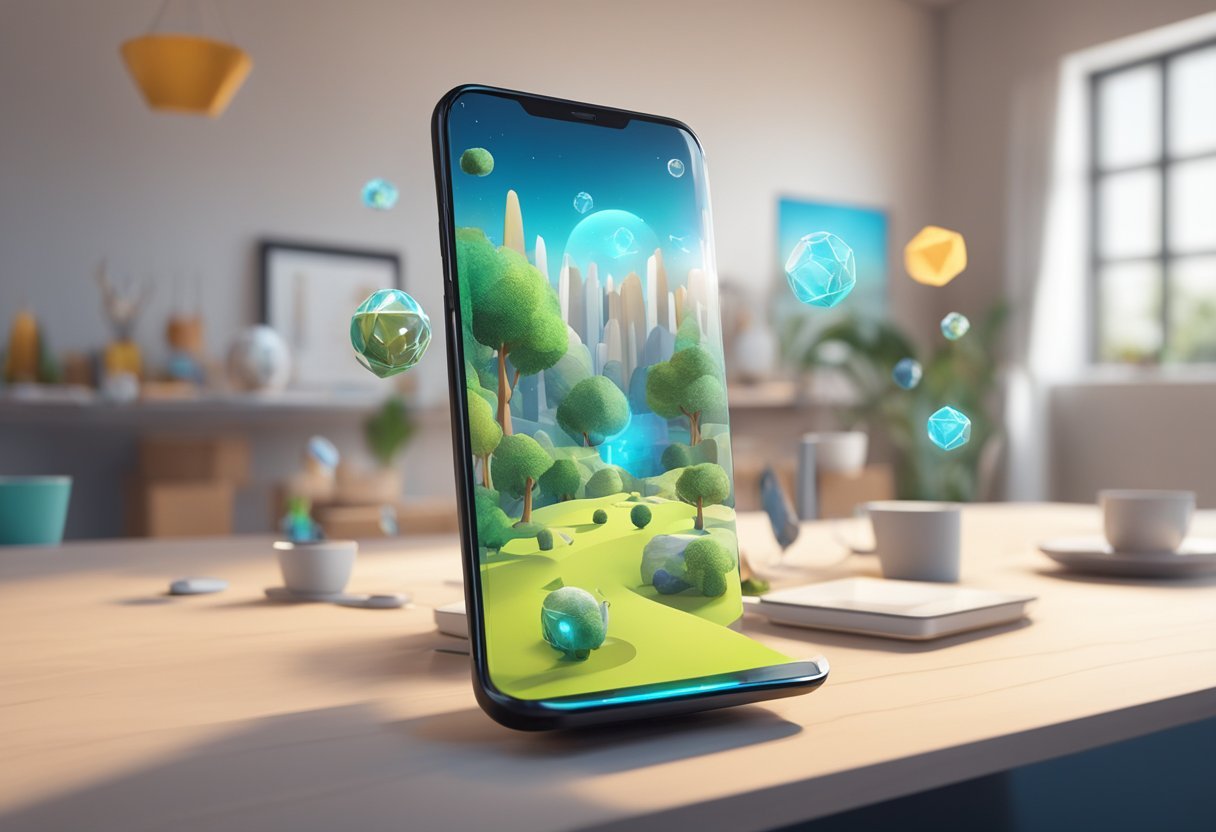Augmented reality (AR) is a rapidly growing technology that has the potential to revolutionize the way we interact with our environment. AR allows users to overlay digital content onto the real world, creating a seamless blend of the virtual and physical worlds. This technology has numerous applications, from education and retail to social media and marketing. In this blog post, I will share with you 10 augmented reality project ideas that you can start today.
If you’re interested in developing AR applications or just looking for some inspiration, there are plenty of augmented reality project ideas to explore. For example, you can create educational experiences that allow students to visualize complex concepts, develop AR applications for retail and commerce, or create cultural and historical AR projects that bring the past to life.
What is Augmented Reality
Augmented Reality (AR) is a technology that overlays digital objects onto the real world. It enhances the user’s perception of reality by adding digital information to the physical environment. AR is different from Virtual Reality (VR), which creates a completely different digital environment. AR can be experienced through a variety of devices, including smartphones, tablets, and smart glasses.
AR vs. Virtual Reality
AR and VR are often compared, but they are different technologies. VR creates a completely digital environment, while AR enhances the real world with digital objects. VR requires a headset or other immersive device, while AR can be experienced through a variety of devices. AR is often used for practical applications, such as training and education, while VR is used more for entertainment.
Key Technologies in AR
AR relies on several key technologies, including computer vision, tracking, and display. Computer vision allows the device to recognize and track the user’s environment. Tracking technology allows the device to track the user’s movements and adjust the AR objects accordingly. Display technology allows the device to overlay the digital objects onto the real world.
The Role of AI in Augmented Reality
Artificial Intelligence (AI) plays a significant role in AR. AI can be used to enhance the user’s experience by providing personalized content and recommendations. It can also be used to improve the accuracy of tracking and recognition technology. AI can also be used to create more realistic and interactive AR objects.
AR is a rapidly growing technology with many practical applications. It enhances the user’s perception of reality by adding digital information to the physical environment. AR relies on several key technologies, including computer vision, tracking, and display. AI plays a significant role in enhancing the user’s experience and improving the accuracy of AR technology.
Augmented Reality in Education
Augmented Reality (AR) is a technology that overlays digital information such as sounds, videos, and graphics on top of the real-world environment. AR is often confused with Virtual Reality (VR), a technology that creates entirely artificial environments. AR provides a unique and immersive experience for students, making learning more interactive and engaging.
Interactive Learning with AR
AR technology has transformed the way students learn by providing an interactive and hands-on learning experience. With AR, students can visualize complex concepts and ideas in a more interactive way. AR allows students to explore the world around them in a more engaging way, making learning more fun and exciting.
AR for Anatomy and Science Education
Anatomy and science education can be challenging for students, but AR technology has made it easier for students to visualize complex concepts. AR technology allows students to explore the human body and other scientific concepts in a more interactive and engaging way. With AR, students can visualize complex scientific concepts in a more interactive way, making learning more fun and exciting.
AR technology has also made it possible for students to work on hands-on projects, allowing them to gain practical experience in a more engaging way. AR technology has transformed the way students learn by providing an interactive and hands-on learning experience. With AR, students can visualize complex concepts and ideas in a more interactive way.
AR technology has a lot of potential in education, and educators are increasingly incorporating it into their classrooms. By using AR technology, educators can create more engaging and interactive learning experiences for their students, making learning more fun and exciting.
10 Augmented Reality Project Ideas

- AR Solar System
- AR Book
- AR Museum
- AR Shopping
- AR Navigation
- AR for Education
- AR in Medical Training
- AR in Surgical Visualization
- AR in Disease Simulation
- AR Interactive Human Body Exploration
AR Solar System
Augmented Reality (AR) can transform the way students learn about astronomy and space science by bringing the solar system into the classroom. An AR Solar System project allows students to visualize and interact with a model of our solar system in a three-dimensional space.
By using AR apps or devices, students can walk around, zoom in, and explore each planet and its features as if they were floating in space themselves. This immersive experience can help in understanding the scale, composition, and the relative positions of the planets, as well as their orbits and other celestial phenomena. AR Solar System projects can also incorporate real-time data to show current planetary positions and movements, enhancing the learning experience with up-to-date information.
AR Book
An AR Book project involves embedding digital content into traditional print media, transforming the reading experience into an interactive journey. By scanning images or pages with a smartphone or tablet, readers can unlock multimedia content such as animations, videos, audio narrations, or 3D models that complement the text.
This technology can be particularly beneficial in educational settings, where AR books can bring complex concepts to life, engage reluctant readers, or provide additional support for students with different learning styles. In literature, AR books can animate scenes from the story or provide historical context, making the reading experience more engaging and informative.
AR Museum
AR technology can enhance the museum experience by adding a layer of interactivity and information to exhibits. An AR Museum project allows visitors to point their devices at artifacts, paintings, or exhibits to access a wealth of additional content, such as historical facts, artist biographies, or even re-creations of historical events.
This can make museum visits more engaging, especially for younger audiences accustomed to digital interactivity. AR can also be used to visualize how artifacts originally looked or were used, providing a deeper understanding of their significance and context.
AR Shopping
AR Shopping transforms the retail experience by allowing customers to visualize products in a real-world environment before making a purchase. For instance, furniture retailers can use AR to let customers see how a piece of furniture would look in their own home, adjusting for size, color, and style.
In fashion, AR can enable virtual try-ons, where customers can see how clothes and accessories would look on them. This technology can reduce the uncertainty that often accompanies online shopping, leading to increased customer satisfaction and potentially reducing return rates.
AR Navigation
AR Navigation projects integrate digital navigational aids into the physical world, simplifying the process of getting from point A to point B. Using a smartphone or AR glasses, users can see directional arrows, distances, and destination markers overlaid onto the real world, making it easier to follow routes in unfamiliar environments.
This technology is particularly useful in complex indoor spaces, like airports or shopping malls, where traditional maps may fall short. AR Navigation can also enhance outdoor experiences, providing tourists with information about landmarks and points of interest as they explore a city.
AR for Education
AR for Education encompasses a variety of applications designed to enhance learning across different subjects and age groups. By bringing abstract concepts to life, AR can provide students with visual and tactile experiences that improve understanding and retention.
For example, AR can be used to dissect a virtual frog in biology class, explore historical sites in social studies, or solve complex 3D geometry problems in math. This hands-on approach caters to various learning styles and can be particularly beneficial for students who struggle with traditional teaching methods.
AR in Medical Training
AR in Medical Training offers a new dimension to medical education by allowing students to interact with virtual patients or anatomical models. This technology can simulate medical scenarios, surgeries, or patient interactions, giving students a safe and controlled environment to practice and hone their skills.
AR can also overlay digital information onto physical mannequins or even real patients, providing additional data and visual guidance during training exercises. This immersive form of learning can improve the depth and quality of medical training, ultimately leading to better patient care.
AR in Surgical Visualization
AR in Surgical Visualization involves the use of AR technology to project digital images or information onto a surgeon’s field of view during procedures. This can include displaying vital signs, highlighting specific anatomical structures, or guiding the placement of surgical instruments.
By providing real-time data and visual cues, AR can enhance precision and safety in the operating room. It also has the potential to facilitate remote assistance, where expert surgeons can guide less experienced colleagues through complex procedures from a distance.
AR in Disease Simulation
AR in Disease Simulation allows medical professionals and students to visualize and understand the effects of various diseases on the human body. By simulating symptoms, disease progression, and potential treatments in a virtual format, AR can provide a deeper understanding of medical conditions. This technology can also be used to demonstrate the impact of lifestyle choices on health, acting as a powerful tool for patient education and preventive medicine.
AR Interactive Human Body Exploration
AR Interactive Human Body Exploration projects enable students and medical professionals to examine detailed 3D models of the human body with an unprecedented level of interactivity. Users can explore different layers of anatomy, from the skin down to the bones and internal organs, often with the ability to isolate specific systems like the circulatory, nervous, or muscular systems. This can aid in the study of human anatomy, pathology, and medical procedures, offering a hands-on approach to learning that can be difficult to achieve with textbooks or cadavers.
AR Project for Retail and Commerce
Augmented Reality (AR) is revolutionizing the way businesses operate, especially in the retail and commerce industry. By integrating AR technology, businesses can enhance their customer experience, boost revenue, and offer innovative solutions to their customers. In this section, we will explore some of the best AR project ideas for retail and commerce.
Virtual Try-On Solutions
One of the most popular ways businesses are using AR in retail is by offering virtual try-on solutions. Customers can use an augmented reality app to try on clothes, shoes, or makeup without physically trying them on. This technology helps customers make better purchase decisions, reduces the number of returns, and increases customer satisfaction. Moreover, businesses can leverage this technology to showcase their products in a more interactive and engaging way.
Enhancing Shopping Experience with AR
AR can enhance the shopping experience for customers by providing them with a more immersive and interactive experience. For example, retailers can use AR technology to create virtual showrooms where customers can see how furniture or home decor items would look in their homes. This technology can help customers visualize products in a more realistic way, which can lead to increased sales. Retailers can use AR to offer personalized recommendations and offers to customers based on their preferences and purchase history.
AR in Furniture and Interior Design
AR is also transforming the furniture and interior design industry. With AR technology, customers can see how furniture would look in their homes before making a purchase. This technology can help customers make better purchase decisions, reduce the number of returns, and improve customer satisfaction. Furthermore, businesses can use AR to offer virtual design consultations, where customers can see how different furniture and decor items would look in their homes before making a purchase.
AR technology is transforming the retail and commerce industry by offering innovative solutions to businesses and enhancing the customer experience. By leveraging AR technology, businesses can increase revenue, reduce returns, and offer personalized recommendations to their customers.
Cultural and Historical AR Projects
If you’re looking to create an augmented reality project that celebrates history and culture, there are many exciting ideas to consider. Here are two subsections that explore some of the possibilities:
Museum Exhibits and Tours
Museums are a natural fit for AR technology, as they allow visitors to interact with exhibits and artifacts in new and exciting ways. With AR, you can create 3D models of historical objects, overlaying them with audio and animations that help bring the exhibits to life. You can also create virtual tours that allow visitors to explore exhibits in a more immersive way, providing them with a unique experience that they’ll never forget.
One great example of a museum that has embraced AR technology is the National Museum of Natural History, which has developed an app called “Skin and Bones.” This app uses AR and 3D animation to bring vertebrate skeletons to life, layering digital muscles and skin projections on top of the glass-encased bones to educate visitors on how the vertebrates move.
AR Art and Public Installations
AR technology can also be used to create stunning public art installations that celebrate history and culture. With AR, you can create interactive exhibits that allow visitors to explore historical landmarks and sites in a more engaging way. You can also create virtual sculptures and installations that are overlaid onto real-world locations, creating a unique and immersive experience that is sure to capture the imagination of visitors.
One great example of an AR art installation is the work of ARtGlass, which has developed a proprietary AR platform to serve the unique needs of cultural sites. They guide visitors on interactive journeys through time and space, creating dynamic, immersive storytelling and educational experiences. In the highly competitive market for attracting visitors, cultural sites need distinguishing features, and ARtGlass provides just that.
AR in Social Media and Marketing
Augmented Reality (AR) has become a powerful tool for social media and marketing campaigns. Here are some ideas for how you can use AR to engage customers and enhance your brand’s social media presence.
Engaging Customers with AR Campaigns
AR campaigns can provide an interactive and engaging experience for customers. For example, you can create an AR scavenger hunt or treasure hunt that encourages customers to visit your store or website to find hidden AR content. Another idea is to create an AR game that customers can play on their mobile devices. This can help to increase brand awareness and generate buzz around your products or services.
AR Filters and Effects on Social Platforms
AR filters and effects on social media platforms such as Instagram and Snapchat can be a fun and creative way to engage with your audience. You can create custom AR filters that feature your brand’s logo or products, or use existing filters to showcase your products in a unique way. AR filters and effects can also help to increase engagement and encourage user-generated content, as customers share their experiences with your brand on social media.
AR can provide a unique and innovative way to engage with customers and enhance your brand’s social media presence. By incorporating AR into your social media and marketing campaigns, you can gain valuable insights and feedback from your community, while also showcasing your brand’s creativity and technological prowess.
Developing AR Applications
If you’re looking to develop AR applications, there are a variety of tools and platforms available to help you get started. Some popular options include Unity, Vuforia, and ARKit. Unity is a popular game engine that can be used to create AR experiences, while Vuforia is an AR development platform that is used to create AR applications for Android devices. ARKit is Apple’s AR development platform, which is used to create AR applications for iOS devices.
Tools and Platforms for AR Development
When it comes to AR development tools and platforms, there are many options available. Some popular tools include Unity, Vuforia, and ARKit. Unity is a powerful game engine that can be used to create both 2D and 3D games, as well as AR experiences. Vuforia is an AR development platform that is used to create AR applications for Android devices.
It provides a variety of features, including image recognition, object recognition, and text recognition. ARKit is Apple’s AR development platform, which is used to create AR applications for iOS devices. It provides a variety of features, including face tracking, scene understanding, and world tracking.
Monetization and Commission Models
When it comes to monetizing your AR applications, there are a variety of options available. You can choose to monetize your application through in-app purchases, ads, or a subscription model. Some companies may be interested in commissioning you to create AR applications for them. For example, Disney recently commissioned a number of AR applications to promote their movies.
In terms of commission opportunities, there are many companies that are interested in developing AR applications. Some of the most popular industries for AR applications include healthcare, education, and retail. If you’re interested in developing AR applications for these industries, it’s important to stay up-to-date with the latest updates and trends in AR technology. One way to do this is by attending industry conferences and events, such as the Augmented World Expo.
Developing AR applications can be a lucrative opportunity for developers who are interested in working with cutting-edge technology. With the right tools and platforms, as well as a solid understanding of monetization and commission models, you can create compelling AR experiences that are sure to delight users.
Frequently Asked Questions
What tools are commonly used for developing augmented reality applications?
To develop augmented reality applications, there are several tools that are commonly used. Some of these tools include Vuforia, ARToolKit, Unity, and Wikitude. Vuforia is a popular software development kit (SDK) that is used to build Android augmented reality applications. ARToolKit is another popular open-source SDK that is used to create augmented reality applications. Unity is a game engine that is used to create augmented reality applications for mobile devices and other platforms. Wikitude is another popular SDK that is used to develop augmented reality applications for iOS and Android devices.
How can students create educational projects using augmented reality?
Students can create educational projects using augmented reality by using tools such as Unity and Vuforia. For example, students can create an augmented reality solar system project that allows the user to explore the solar system’s planets and other celestial bodies in a 3D environment. Another idea is to create an augmented reality history project that allows the user to explore historical events and landmarks in a 3D environment.
What are some beginner-friendly augmented reality projects?
Some beginner-friendly augmented reality projects include creating an augmented reality coloring book, an augmented reality puzzle game, or an augmented reality scavenger hunt. These projects can be created using tools such as Vuforia and Unity.
Where can one find augmented reality projects with available source code?
One can find augmented reality projects with available source code on websites such as GitHub, Unity Asset Store, and Vuforia Developer Portal. These websites offer a variety of augmented reality projects with available source code that can be used as a starting point for creating your own projects.
Can you provide examples of mixed reality projects for a final year thesis?
Mixed reality projects for a final year thesis can include creating an augmented reality game that combines real-world objects with virtual objects, an augmented reality shopping application that allows users to try on virtual clothing, or an augmented reality museum exhibit that allows users to interact with virtual exhibits.
What are the three main types of augmented reality and their applications?
The three main types of augmented reality are marker-based, markerless, and projection-based. Marker-based augmented reality uses a physical marker to trigger the display of virtual content. Markerless augmented reality uses computer vision algorithms to detect and track real-world objects. Projection-based augmented reality projects virtual content onto real-world surfaces. These types of augmented reality have applications in fields such as education, entertainment, and marketing.




